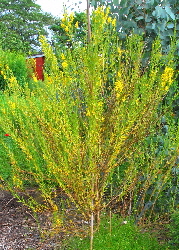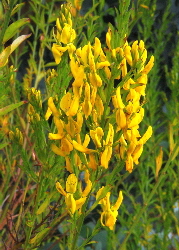|
(Genista tinctoria)
 1) Biology of Dyers Greenweed 1) Biology of Dyers Greenweed
2) History of Dyers Greenweed
3) Growing Dyers Greenweed
4) Harvesting Dyers Greenweed
5) Dyeing with Dyers Greenweed
Biology of Dyers’ Greenweed
This deciduous perennial shrub is a member of the legume family and grows to slightly over 1.5 metres tall. The shrub is similar to the ornamental broom grown in gardens, with thin leaflets about 2.5 cm long. The attractive yellow flowers appear from June to September and the plant is self-fertile. The seed pods are black and mature around October and November in the UK.
History of Dyers’ Greenweed
Remains of this plant have been found in Viking archeological sites, making it an ideal plant for Viking reenactors.
Growing Dyer’s Greenweed
Sow the seeds in the autumn. Soak the seeds overnight in warm water and sow one seed per pot. Leave the pots outside in all weather to break the seeds dormancy. Germination is erratic with the first seedlings appearing in two to three weeks, and the last one up to four months later.
Let the plant grow to 30 cm high before carefully planting it into its final position. Think carefully before planting this bush, as it does not transplant at all well. Dyers Greenweed prefers a sheltered position but does not like shade. I have not found this an easy plant to grow; it is susceptible to wind damage and needs to be very well staked and tied up.
It takes nearly two years for the young plants to reach full size. Dyers' greenweed can also be reproduced from cuttings, but the success rate is not high and the plants do not grow very fast.
You can try to save your own seeds, but very few seeds are produced in a cold year. Dry the small black seed pods in a container with a loose lid on top, as you will find that the pods split open as they dry and they often jump quite a distance.
Harvesting Dyer’s Greenweed
Harvest the plant by cutting branches about two weeks after it has started to flower. This pruning helps to reduce wind damage later on in the year. If you are not using the leaves straight away, dry and store the cuttings out of sunlight.
Dyeing with Dyers’ Greenweed
Dyers’ Greenweed contains luteolin, the same water-fast pigment as weld. You can follow the instructions for dyeing with weld to obtain clear yellows.
The once famous Kendal green was wool dyed yellow with greenweed and overdyed with woad or indigo.
Top of Page
|